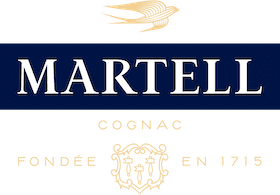Collection
Cocktails
La maison
Visit Us
How is cognac aged ?

Maturation of cognac in barrels
Ageing is essential to the process of making cognac. A time-honoured tradition in which the eaux-de-vie distilled from precious white wine grapes is matured in oak barrels. At Maison Martell, these casks are constructed exclusively from fine-grained French oak.
Yet how does the ageing process affect cognac exactly, and why is it so important? Let’s explore the key dates.
October
France’s most famous amber spirit is made from grapes grown exclusively in the Cognac region of France. These are harvested around the month of October once they reach maturity, depending on the year.
The grapes are then pressed and the must fermented into a wine. Unique among leading cognac houses, Maison Martell rests this wine until it is ‘clear’, meaning the lees are removed and it is free of sediment.
November 1
From the start of November, the clear wine is distilled into eaux-de-vie, using a double distillation process in copper pot stills.
April 1
For any cognac, the ageing process starts on April 1 of the year following the harvest.
It is during the ageing process the cognac develops its distinctive colours and flavours. Contrary to popular belief, ageing does not always make a cognac significantly darker, particularly if aged in very old casks.
2 years
An eau-de-vie must be aged a minimum of two years before it can be referred to as cognac. For clarity, Maison Martell makes an important distinction, only referring to a finished blend of eaux-de-vie as cognac.
Cognac made from eaux-de-vie among which the youngest has been aged two years is classified as VS, for Very Special. The English terms given to cognac categories reflect the international origins of many cognac producers, who heralded from places as far-flung as Scandinavia and Ireland. Jean Martell was in fact an Englishman from the island of Jersey.
4 years
VSOP cognac, Very Superior Old Pale, blends eaux-de-vie aged four years at least. During this time, the influence of the cask on the eau-de-vie becomes more apparent, giving off aromas such as wood and coconut. The term Napoleon is sometimes used to describe a VSOP made from eaux-de-vie aged for at least six years.
The type of barrels in which the eaux-de-vie ages influence the character. Martell Distinction, for example, is a VSOP characterised by spicy and woody overtones. This reflects the larger than usual proportion of new oak barrels in which it is aged. This unique structure, rich in tannins, makes Martell Distinction ideal for food pairing.
Beyond 10 years
As of 2018, XO cognac must be made of eaux-de-vie aged for a minimum of 10 years, and 14 years for XXO cognac.
Eaux-de-vie may be aged for even longer, sometimes 30 or 40 years, depending on when the cellar master judges the spirit to have reached its maturity. Once mature, the eaux-de-vie are transferred to a dame jeanne, an 11-litre glass flask, which preserves and protects the spirit for ever more.
Martell cognacs by age
VS cognacs (eaux-de-vie aged a minimum two years)
Martell VS
VSOP cognacs (eaux-de-vie aged a minimum 4 years)
Martell VSOP
Martell Distinction
Martell Noblige
XO cognacs (eaux-de-vie aged a minimum 10 years)
Martell Cordon Bleu
Martell Cordon Bleu Extra
Martell XO
XXO cognacs (eaux-de-vie aged a minimum 14 years)
Martell Chanteloup XXO
Martell Single Estate Collection
L’Or de Jean Martell
Please do not share with anyone under 18. Drink responsibly.























